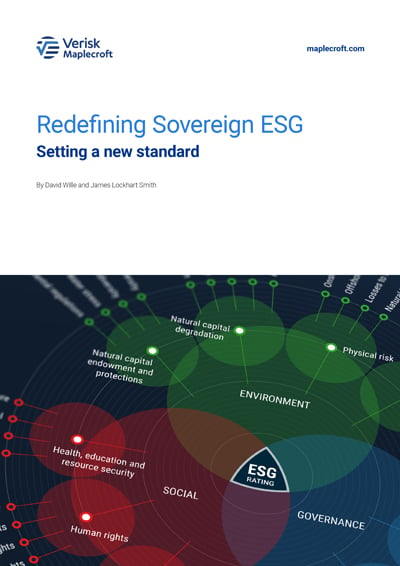Redefining Sovereign ESG – Setting a New Standard
Executive Summary – read our whitepaper
by James Lockhart Smith and David Wille,
The climate emergency, Covid’s socio-economic shock waves, impatient asset owners, and aggressive regulation have called time on the version of ESG investing that threatened to prevail. Investors now face growing pressure to replace minor tilts or marginal exclusions with genuine ESG incorporation that potentially creates tough trade-offs between returns and impacts.
Sovereign debt is no exception.
The state of sovereign ESG – data and analytical challenges abound
The last two years have underscored that governments should be the guarantors of last resort when it comes to health – but that applies equally to human rights, prosperity and the protection of natural capital and the climate. The surge in interest in sovereign ESG investing means there is now an urgent need to better understand governments’ sustainability impacts and dependencies.
However, many asset managers still struggle on the data front. Lagging and often single-issue NGO and IGO datasets, or the commercial solutions that transform them, aren’t enough. Credit ratings agencies have begun to incorporate ESG into their assessments of sovereigns, but these efforts only reflect the ESG considerations that these organisations believe pose a near-term threat to solvency. A trusted standard that robustly assesses all ESG factors that are relevant from either an ethical or a material perspective is needed: a single point of reference that can fill the gap for investors looking to price ESG in their sovereign portfolios more effectively and align with the values and expectations of their clients and stakeholders.
We’ve been working with investors at the vanguard of evolving best practices in sovereign ESG as interest in the area has increased over the past decade. These firms have the resources and expertise required to build proprietary models that draw on a subset of our industry-leading 1200+ indicators, which are in turn based on geospatial, unstructured, structured and expert-scored sources. But our new Sovereign ESG Ratings, which analyse all countries on a quarterly basis using almost 350 indicators and 37 issues across nine dimensions of ESG risk, take this one step further.
Sovereign ESG needs a new standard
We’ve designed the Ratings to help investors of all types, including asset owners and managers large and small, to efficiently put ESG at the centre of their investment processes. If this is done at scale across the sovereign debt investment ecosystem, it will help ensure that the true cost to governments of their ESG externalities, and the value to them of ESG opportunities, begins to be more efficiently reflected in market pricing.
We also offer the Ratings as a market standard for high-level analysis, ranking, reporting and screening that thoroughly assesses all aspects of sovereign ESG. This will allow investors to challenge their own models and assumptions with a robust and unbiased third-party view.
Our 20 years’ experience and credibility in this field means users can expect unrivalled depth in relation to the scope of issues and issuers covered, and be confident in our methodological rigour, the reliability of our source data, and our independence from government influence. We take a principled and precautionary approach to issue selection, including on human and labour rights, that looks beyond the limited perspective provided by research on various issues’ recent market materiality. In addition, we include the option to adjust the ratings by income to support the subset of use-cases for which income adjustment is valid.
Departing from traditional approaches to sovereign ESG, the analytics underpinning the Ratings also provide unique new intelligence for even the most advanced investors on a country’s performance, how it stacks up against its peer groups, and, critically, its momentum or change when it matters most for market pricing. Specifically, we introduce a methodology that is tailored to the non-linear world of sovereign ESG. The analytics allow investors to better position their portfolios to minimise downside risks and capitalise on emerging investment opportunities by understanding when changes in the ESG profiles of the sovereigns in their universe could impact market pricing. This is particularly important when, as is likely in 2022, the debt servicing costs of frontier and weaker emerging issuers come under heightened stress.
Driving sovereign ESG risk analysis with unique, highly material scores and data analytics
Our whitepaper ‘Redefining Sovereign ESG – setting a new standard’ explains the structure of the Ratings and the methodology that underpins them, and then analyses the Ratings’ materiality for sovereign debt pricing. We’ve found that government bond markets remain stubbornly inefficient when it comes to ESG, but the tipping points encoded in the structure of our Ratings provide the signals that are critical in determining debt prices. In addition, we show human and labour rights are now highly material, and how environmental issues – and climate risks in particular – have begun to affect spreads. Finally, we observe that both environmental and governance factors are leading indicators of changes in market sentiment towards issuers, but that these typically take a year to filter through.
Want to learn more?
- Webinar: Setting a new standard – introducing Verisk Maplecroft's new Sovereign ESG Ratings for investors (09 March at 1500 GMT / 1000 EST, and available on-demand afterwards)
- Webinar: ESG risks and opportunities for sovereign debt investors in the Americas region – lessons from our new Ratings (23 March at 1500 GMT / 1100 EDT, and available on-demand afterwards)
Discover our Sovereign ESG Ratings, Insights and the wider Sovereign ESG Intelligence we deliver for investment managers, asset owners, hedge funds, banks and insurers.


